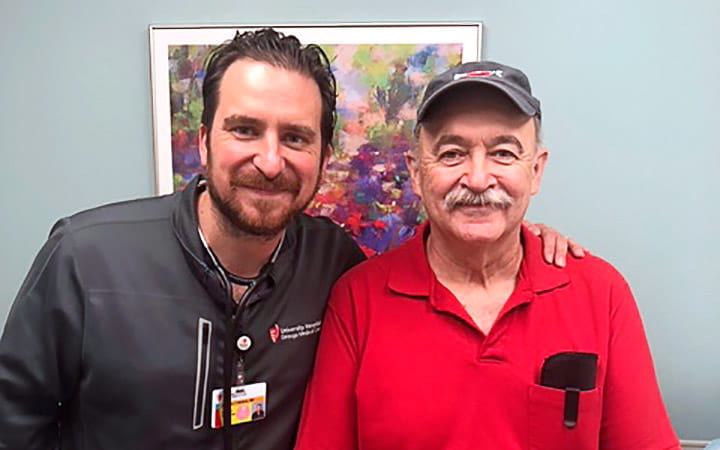Man Survives Massive Heart Attack after 30+ Defibrillations
August 14, 2019

30+ defibrillations save a patient’s life
A Northeast Ohio man who experienced what likely would have been a deadly heart attack is home with his family thanks to the steadfast medical professionals determined to save his life.
“This is a pretty amazing story,” said Geoffrey Patty, Chest Pain Coordinator with UH Harrington Heart & Vascular Institute at University Hospitals Geauga Medical Center. “This was a real save, a phenomenal effort from the EMS, the emergency department and the UH Geauga Harrington Heart & Vascular team.”
STEMI at Home, Followed by V-Fib
On June 4, Hiram Fire/EMS responded as 63-year-old Franklin Briggs experienced severe chest pain. Paramedics performed an electrocardiogram at his home and identified his symptoms as STEMI, a “full-blown” heart attack caused by the complete blockage of a heart artery. STEMI has a substantial risk of death and calls for an immediate response.
In the ambulance, Briggs became unresponsive when his heart attack caused a potentially fatal heart rhythm disturbance called ventricular fibrillation. Ventricular fibrillation leads to death if not treated immediately with defibrillation.
“Defibrillation is performed by delivering electricity through the chest in an attempt to reset the heart into normal rhythm,” said Gregory Stefano, MD, Medical Director of the UH Harrington Heart & Vascular Institute at UH Geauga Medical Center. “It’s just like on TV when the Grey’s Anatomy staff yells ‘clear’ and they shock the patient with paddles.”
An Extraordinary Number of Heart Defibrillations
Hiram Fire/EMS administered the first of what would turn out to be an extraordinary number of heart defibrillations. That shock reset Briggs’ heart to normal rhythm. However, when he arrived to the emergency department of UH Geauga Medical Center, he again went into ventricular fibrillation and this time it led to full cardiac arrest. For the next 45 minutes, medical personnel worked tirelessly to keep Briggs alive by administering drugs as well as continuous CPR with chest compressions and defibrillations over and over.
Briggs received 26 shocks to his heart in the ED and five more in the cardiac catheterization laboratory inside the hospital, where he was taken in an effort to open the blockage that led to ongoing cardiac arrest. In the cath lab, the team continued CPR while Dr. Stefano identified a 100 percent blocked artery and opened it with a stent. He also inserted a device called an intra-aortic balloon pump to help relax the heart and promote blood flow to the arteries. After these measures were taken, Briggs received a 34th and final defibrillation and his heart regained normal electrical function.
One in a Million
“I’ve been doing this a long, long time and I cannot remember a person who was shocked 30 times and walked out,” said Patty. It’s statistically improbable that someone who came in presenting with those symptoms would leave the hospital without any brain injury or even alive at all.”
Only a small number of people who come to UH Geauga’s cath lab need shocked at all, let alone 30 or more times. Between January and May of this year, only 6 percent of cath lab patients (five patients out of 73) received a defibrillation, usually between one and three times.
“One in a million shot,” said Briggs about his chances of survival after this type of cardiac event. Everybody was helpful. I’m so grateful to everyone for what they did.”
Franklin Briggs is now recovering at home in Hiram, Ohio, spending time with his wife and family. He returns to UH Geauga for rehab three times a week.


